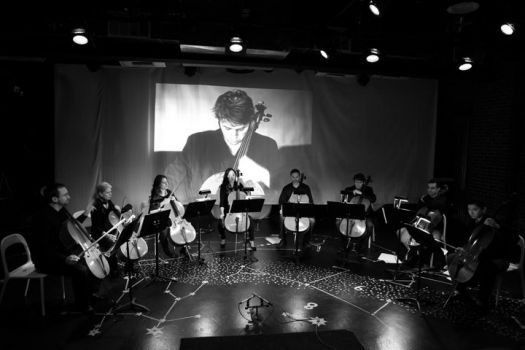
Cellos More than Mellow in Handsome Space
There is no
sound quite like a cello.

Thanks to
concert:nova, Cincinnati heard the instrument at its most eloquent Monday evening in the Mercantile Library
downtown.
“Cello Portraits” was a study in eight, including c:n cellists Christina Coletta and Theodore Nelson, Cincinnati Symphony Orchestra principal cellist Ilya Finkelshteyn, CSO cellists Tao Ni, Susan Marshall Petersen and Alan Rafferty, Cincinnati free lance cellist/teacher Sarah Kim and special guest, New York cellist Richard Belcher of the Enso Quartet. What better location to relish these mellow sounds than the handsome space of century-old Mercantile Library, surrounded by books, paintings and sculpture?
Of course, a
cello can be much more than mellow. From
deep bass to the upper reaches of its highest string -- where it can sing like a
violin -- the cello is capable of a wide range of expression.
The great Spanish cellist Pablo Casals (1876-1973) spurred the development of cello choirs in the 20th century. Today there are such distinguished ensembles as the 12 Cellists of the Berlin Philharmonic and the Yale Cellos, both of which record. Ultimately, the genre derives from the “consort of viols,” a grouping of violas da gamba (antique cousin of the cello) popular during the Renaissance and baroque periods.
The concert had a multi-media dimension. As the title "Cello Portraits" indicates, there were visuals, in this case photography and not just pre-existing slides, but black-and-white images shot and projected during the performance by renowned arts photographer Michael Wilson with technical support by Varland Photography of Cincinnati.
It was a bit disconcerting at first to see Wilson creeping around the players with his camera. He was not a constant presence, however, and there was no disturbance by way of camera clicks or the like. As for the photos, they were quite engaging, with close-ups of hands, bows, fingerboards, bridges and faces intent on making music.
The music was a mix of baroque, romantic and contemporary, even the Beatles. To showcase the cello’s song like quality, the program opened with a group of eight-part motets (sung pieces) by Brahms, arranged for cellos by Douglas B. Moore,*“Ich aber bin Elend” (“But I am full of woe”), “Wenn wir in Höchsten Noten Sein” (“When we are in deepest need”), both from Op. 110, and “Wenn ein Starker Gewappneter” (“When a strong man armed”), Op. 109, No. 2. You’ve never had your ears caressed so warmly as by these eight cellos in that unique venue, as their tone colors fleshed out the words and music.
Next was the
1891 Requiem by Czech composer/cellist David Popper (a name known to all cellists for his
etudes). Originally for three cellos and
orchestra, it was heard in a lovely arrangement by Edward Laut** for cello sextet, featuring Tao Ni.
Nelson introduced “Messagesquisse” (“Cryptic Message”) by Pierre Boulez, a 1977 modernist work for solo cello and six cellos built on the letters of Boulez' friend and patron Paul Sacher's last name. Nelson explained that it is very strictly composed, using six-note motifs, Morse Code and other rigorous techniques, making it a forbidding work to contemplate.
However -- to paraphrase Mark Twain, who described Wagner’s music as “not as bad as it sounds” -- the seven-minute work sounded better than its description. A scenario might have read: 1) Cellos spell the name, letter by letter (Sacher is spelled E-flat-A-C-B-E-D in mixed musical notation). 2) Cellos chase each other madly. 3) Solo cello (Nelson) grouses by himself. 4) Cellos resume the chase. All great fun.
Following wine and snacks, the concert resumed with the Chaconne from Bach’s Partita No. 2 in D Minor for Solo Violin, arranged for four cellos by Laszlo Varga.*** It was a glorious. concerted sound, five cellos doing what (apologies to the cellists) a single violin does in Bach's famous Chaconne. Rafferty, Kim, Tao Ni and Nelson each brought a distinctive tone quality to the mix.
Coletta introduced and performed two songs with a quartet comprising Belcher, Nelson, Tao Ni and Petersen, Gustav Mahler’s “Liebst du um Schoenheit” (“If you love for beauty”) and Gabriel Faure’s “Le Secret,” arranged for cello choir by Moore. Coletta read the poems on which they are based, further underlining the beauty of her presentation.
Two of the best known works for cello ensemble are from Heitor Villa-Lobos’ “Bachianas Brasileiras.” Translated roughly "Brazilian Bach Pieces," this well known set is the composer’s homage to Bach. All eight cellists re-grouped and were led masterfully by Finkelshteyn in “Bachianas Brasileiras” No. 1. From the vigorous Introduction (“Embolada”) to the soulful Preludio (“Modhinha”) to the playful Fugue (“Conversa”), the work's blend of folk and European traditions was conveyed brilliantly by the entire ensemble.
“B” stands
for “Beatles” and also for “best,” which the group saved for last. Inspired, said Rafferty, by the Berlin
Philharmonic cellists and their album “Cello Submarine,” the Cincinnati cellists
called upon c:n keyboardist and arranger Julie Spangler to do their own Beatles
arrangement. She did and how, with “I am the
Walrus” and “Across the Universe.”
Rafferty opened with a swift flourish down to his open C string. The octet seemed to grow collective tusks as they dug into the gritty, exhilarating music, dropping some “hoo, hoo, hee
hee and ha, ha’s” into their “Walrus” interpretation, then easing into “Across the
Universe,” which soared.
The concert was an eye and ear-opening experience that begs for a repeat. Happily, it will have one at 7 p.m. Dec. 13 at Ichiban Japanese Restaurant, 1020 Delta Ave. in Hyde Park. The dinner concert will include Villa-Lobos’ well known“Bachianas Brasileiras” No. 5 for cellos and soprano voice, plus other selections from "Cello Portraits." Gastronomically speaking, it will also mark the "debut" of the “concert:nova sushi roll." The cost is $75 per person. For information and reservations, call (513) 886-2436, or visit the concert:nova web site at www.concertnova.com
*Professor emeritus at Williams College in Williamstown, Massachusetts
**Professor at the University of Kansas in Lawrence, Kansas
***former principal cellist of the New York Philharmonic